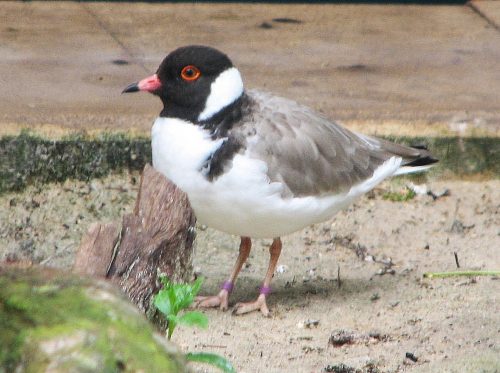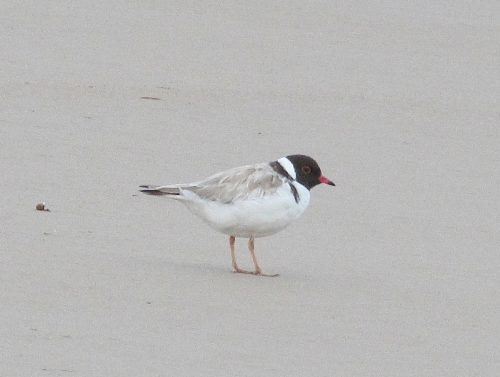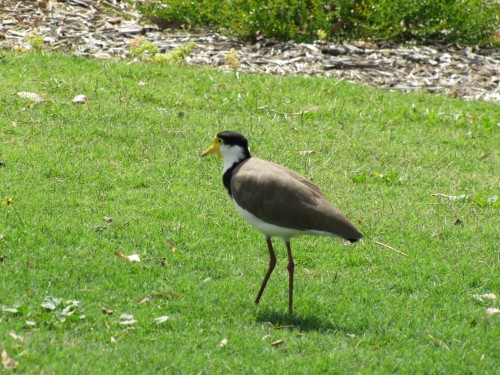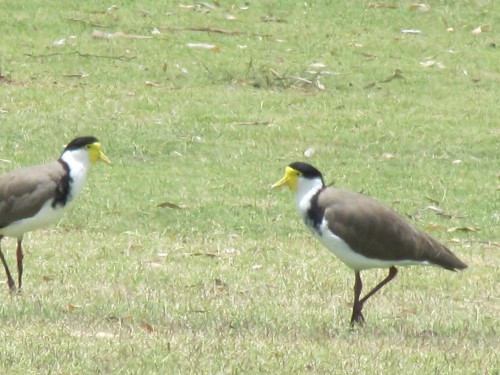An appeal to save our Hooded Plovers
Here in South Australia, there has been some interest generated in the media in recent weeks about the plight of the Hooded Plover. A pair of this species was found to be nesting on one of our popular beaches. There was much concern over protecting the eggs from damage or predation.
This tiny bird is widespread along the coast of South Australia and all of southern Australia, including Tasmania. Nowhere is it common, and everywhere it is threatened. It is estimated that fewer than 2500 of these lovely birds exist. And during the summer months, when they nesting, they are most vulnerable.
During the summer months, when they nesting, they are most vulnerable. They make their nest by making a small depression in the beach sand. In this hollow, they lay and hatch their eggs. Surveys have shown that as few as only 2.5% of eggs actually make it to adulthood. That is a shocking statistic; it is NOT a typo.
The eggs can be damaged in many ways:
- The eggs can be trampled on by people, dogs, horses or vehicles (we still have some beaches with car access here in South Australia – all in Hooded Plover nesting areas).
- Overheating when the eggs are exposed to the burning sun after the adult is scared from the nest.
- Eggs left too long and becoming too cold without the warmth of the adult sitting. This also happens when the adult is chased from the nest by the presence of humans, dogs, and other animals.
- The eggs can also be taken by predators such as foxes, cats, ravens, magpies, gulls and eagles.
If the eggs survive to hatch, the young can die:
- By being run over by vehicles, or stepped on by humans.
- Eaten by predators like foxes, cats, and birds of prey.
What you can do
You may be thinking that you can’t do much to save these, and other, threatened birds.
Think again.
Just by being aware of our wildlife when you go to the beach this summer, and drawing the plight of birds like the Hooded Plover to the attention of family, friends and other beach goers, you can do your bit to save them for future generations.
Donate
I don’t often make appeals for money on this site; in fact, I am sure I have never done so. This is different. Birdlife Australia is running a special appeal for these little birds this summer. You can donate here.
Become a Member
Why not become a member of Birdlife Australia? I have been a member for many decades. They pour large amounts of money into bird conservation, advocacy and research. Membership also provides you with discounts on a range of products and services, and you get their colourful quarterly magazine as well. You can join here.
Further reading:
Good birding,
Trevor
Australian Botanic Gardens part 3 Masked Lapwing
Many people don’t like lapwings (plovers), especially the Masked Lapwing shown in today’s photos. The reasons are various, including the fact that they make their nests on the ground, usually a lawned area like that shown in today’s photos. The Australian Botanic Gardens at Mt Annan have large areas of lawn or grassy areas, suitable for picnics and large gathering such as concerts. The local community had celebrated their Christmas Carol singing for 2013 the night before we were there. While it is ideal habitat for the Lapwings, their preference brings a conflict with humans. Most people are reluctant to mow the grass or lawn while the birds are sitting on eggs.
Breeding season for the Masked Lapwing brings about another point of conflict with human occupation of the same space. Lapwings aggressively defend their nest and territory, swooping any person, dog, cat or cyclist who dares invade their domain. A screeching, swooping lapwing – it’s more of a attack fighter plane dive – is a terrifying experience for some and an unnerving encounter at best. Young children are particularly at risk. The spurs on the “elbow” of the wing can cause injury if the swooping bird contacts the intended victim. I might add that contact is rare, and injuries usually minor. Psychological damage can be the most severe outcome; some people are definitely traumatised by a close encounter.
Hooded Plovers
Early last year I took this photo of a sign on the beach front at Victor Harbor, about an hour’s drive south of Adelaide in South Australia. The message of the sign is quite clear. This beach is one of the nesting places of the rare and endangered Hooded Plover. The beach also happens to be one of the busiest in the state during the summer holidays and is even popular at most other times of the year.
Hooded Plovers are confined to coastal areas of southern NSW, Victoria, Tasmania, South Australia and parts of Western Australia. Nowhere is it common and, as the sign says, very few are left in places like the Fleurieu Peninsula south of Adelaide. The birds are small (about 19-23cm) and tubby, and their favoured habitat is broad sandy ocean beaches. The nest is a small shallow scrape in the sand where they lay 2-3 eggs.
If my memory is correct, this beach at Victor Harbor is the only place I’ve ever seen this species nesting. I was leading a large group of young children on camp when we came across a nest. Keeping 60 eager children away from the nest was a logistical nightmare. I’ve only ever seen this species on a handful of occasions, mainly on the Yorke Peninsula further west in South Australia. I have no photos of the Hooded Plover. I must try to get one when I visit the town again in about a week’s time.
Further reading:
Do Blackbirds Swoop? How to Deal with Aggressive Bird Behaviour
Do Blackbirds Swoop?
This intriguing question was posted by Jill on one my earlier articles. I assured her in my reply that I have never heard of this species swooping humans.
You have nothing to fear where Common Blackbirds are concerned. I have never experienced swooping with this species. In fact, they are usually rather timid and will readily fly away from humans. I have checked on the internet and found no recorded instances of Common Blackbirds swooping humans.
I also read through the article on Common Blackbirds in HANZAB (Handbook of Australian New Zealand and Antarctic Birds Vol.7) and there is no mention of this behaviour. HANZAB is THE authority on Australian birds and is a compilation of all research done on birds in this region, including a comprehensive overview of all the relevant published literature on birds.
UPDATE: Since writing this article I have had many comments about Blackbirds swooping. Many have claimed that they do swoop. These comments have always come from American readers. I was writing about the Common Blackbird, an introduced species in Australia. They come from Europe and are not related to several species found in America which do swoop. The Red-winged Blackbird of north and central America is very aggressive I believe. Some readers may also have been confused by my comments, thinking I was talking about the Grackle.
Magpies and Lapwings
Most Australians know about the problem with Australian Magpies and swooping. They need to be given a wide berth when nesting. What many people do not know is that Masked Lapwings (also called Spur Winged Plovers) can inflict a nasty wound. Keep away from their nests or young is the message they are giving. On most occasions their attack is 95% bluff and injuries are rare. Last spring there was a very unusual news report on television showing footage of Magpie Larks attacking humans near the Festival Centre in the CBD of Adelaide. This is the only occasion I have known of this species swooping like their bigger cousins.
Kookaburras and Butcherbirds
Other species that may occasionally swoop include Kookaburras (one individual once took a sausage from a barbecue I was cooking). I once had an opportunistic Grey Butcherbird snatch a sandwich from my hand while on a picnic. In both these cases they were swooping for food – not attacking me. Gave me a fright though.
Geese, Ducks and Swans
In parks and gardens as well as zoos and wildlife parks, any of the species of geese can get a little aggressive. This is often as a result of too many people feeding them. Many species of ducks can also get this way. I’ve even known Black Swans to act aggressively. In most cases they are after food; they are not intending to harm people.
Pelicans
I have heard of an instance of an Australian Pelican eating a small dog on the riverfront at Renmark in South Australia. I’m not sure if this is a true story or an urban myth, but pelicans would be quite capable of this. What I have witnessed was rather scary. We had visited the bakery at Mannum and were sitting on a seat near the riverfront eating our lunch. A pelican came up to us and almost snatched a sausage roll from the hand of my daughter-in-law. Having a pelican a metre away staring you directly in the eye is very unnerving.
Emus and Cassowaries
Many years ago while visiting a zoo in the SW of Western Australia I had another unnerving encounter, this time with an Emu. I was in a walk through enclosure containing ducks, geese, emus and kangaroos. One Emu took a liking to my camera lens and my glasses. Being followed by an Emu – no – harassed is a better word – was distressing, especially as the said Emu constantly tried to peck either my glasses or the camera lens. I was so constantly under attack that I had to quickly leave the enclosure, much to the amusement of my family!
The Southern Cassowary of northern Queensland has a reputation for being aggressive towards humans. I don’t have personal experience of this species, but I know that when I do visit that region, I’m going to be wary of the cassowary!
Ibises and Gulls
Gulls and picnics seem to go together. Especially when you produce some fish and chips. It is as if you’ve put up a huge neon sign saying “Come to the feast.” Again, this is as a result of feeding by humans and not a direct attack to harm. Having said that, it is intimidating and annoying to have a Silver Gull standing on your picnic table 30cm away from your lovely chips. In some parts of Australia, Ibises are a major problem too, snatching food from children in particular. Our larger Ibis species are almost as large as a toddler learning to walk. Scary stuff for a youngster.
Willie Wagtail
Willie Wagtails are generally loved by all Australians and is one of our most recognisable birds. What most people do not realise is that these endearing little creatures can be very bold and aggressive when there are babies in a nest nearby. Our resident Willie Wagtails have given us a little tweak on the head if we venture too close to the nest. And they are not too slow to attack birds much bigger than themselves; even our largest eagle, the Wedge Tail, is not immune from harassment.
Honeyeaters
Honeyeaters are not known for their aggression towards humans. If you get too close to their nest they will let you know, scalding you incessantly from a nearby branch. However, they can be very bold. Many years ago a friend in Port Augusta related to me an occasion when a honeyeater landed on his shoulder and tried to pluck a hair from his rather ample beard. While this incident is not a display of aggression, it does show how courageous they can be.
Eagles
There have been a few recorded instances of people being attacked by eagles, hawks and other raptors. Only last year I was aggressively swooped by what I think was a Brown Falcon. I can’t be sure because I didn’t hang around too long. I was invading his territory so I beat a hasty retreat. He didn’t contact any part of me but it was a little unnerving.
How to Deal With Aggressive Bird Behaviour
- Give the birds space – keep away from their nest or their young. Think about how you would react if a large monster invaded your home. They are protecting their offspring so respect their space. If there is a magpie nesting on your usual walking route, try to take an alternative route until the nesting has finished.
- Wear protective clothing – this is particularly so with swooping magpies. Wear a hat or helmet to avoid injury. Some people say that painting large eyes on the back of a helmet, hat or cap helps to deter magpies from swooping.
- Don’t feed native birds – if everyone followed this rule there wouldn’t be a problem but it is probably too late for that. If you are having a picnic, don’t be tempted to throw food scraps to the gulls of ducks or whatever is nearby. Just one chip or bread crumb thrown at one bird will often result in dozens of birds flocking to your picnic ready for a handout. In the case of Gulls, it could result in hundreds surrounding your picnic spot.
- Carry a stick – I’ve proved this to be effective with magpies swooping. Carry a stick above one’s head as you walk through a magpie nesting zone. This deters them from attacking your head. Decorating the stick with ribbons can add to the distraction level.
- Carry a flag – this one is mainly for cyclists. Mount a pole on your bike with a flag at the top. It will help motorists see you too!
Readers’ Contributions:
I invite readers to leave their comments about their experiences with aggressive birds.
- Which birds have swooped you?
- How have you been harmed by birds?
- What about birds in other countries? Do they swoop or attack?
- What solutions to aggressive bird behaviour can you share with readers of this blog?
UPDATE:
- Readers on this blog have contributed many interesting comments – click on the comments section below this post.
- I have written a followup article called A Bit on the Nose. This post quotes in full an amusing email sent to the the Birding-Aus forum today. Special thanks to Bill for permission to quote the email in full.
Related articles and links:
- Common Blackbirds – my article that started me on this post.
- ProBlogger – this article has been submitted to the Group Writing Project “How to…” being run by Darren Rowse on ProBlogger.








